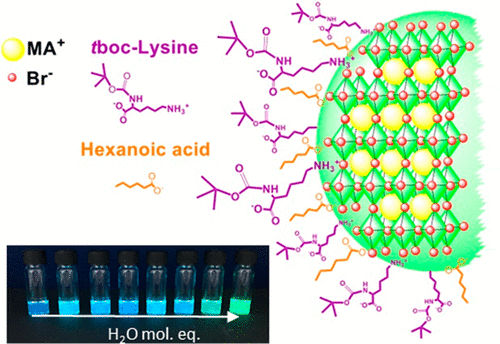当前位置:
X-MOL 学术
›
ACS Appl. Nano Mater.
›
论文详情
Our official English website, www.x-mol.net, welcomes your
feedback! (Note: you will need to create a separate account there.)
Controlling Quantum Confinement in Luminescent Perovskite Nanoparticles for Optoelectronic Devices by the Addition of Water
ACS Applied Nano Materials ( IF 5.3 ) Pub Date : 2020-01-17 , DOI: 10.1021/acsanm.9b01857 Anna Jancik Prochazkova 1, 2 , Yolanda Salinas 3 , Cigdem Yumusak 1 , Markus Clark Scharber 1 , Oliver Brüggemann 3 , Martin Weiter 2 , Niyazi Serdar Sariciftci 1 , Jozef Krajcovic 2 , Alexander Kovalenko 1, 2
ACS Applied Nano Materials ( IF 5.3 ) Pub Date : 2020-01-17 , DOI: 10.1021/acsanm.9b01857 Anna Jancik Prochazkova 1, 2 , Yolanda Salinas 3 , Cigdem Yumusak 1 , Markus Clark Scharber 1 , Oliver Brüggemann 3 , Martin Weiter 2 , Niyazi Serdar Sariciftci 1 , Jozef Krajcovic 2 , Alexander Kovalenko 1, 2
Affiliation

|
Here, a simple method for controlling the size of the perovskite nanoparticles (PNPs) during preparation is reported. Metal halide PNPs have great potential for application in optoelectronic devices, such as light-emitting diodes, lasers, photodetectors, etc. They have exceptionally high photoluminescence quantum yields (PLQYs) and exhibit chemical tunability for versatile modifications of the perovskite structural composition, enabling the synthesis of nanoparticles with controlled size, shape, and optical properties. In this work, methylammonium lead bromide PNPs were prepared using a hygroscopic stabilizing ligand, tert-butoxycarbonyl-Lysine (tboc-Lysine). Water was used as an additive in the precursor solution, which resulted in the formation of highly mobile species and, thus, the nhancement of perovskite lattice growth. This method allowed the preparation of PNPs with controlled size between 4 and 7 nm. The quantum confinement effect led to a fine-tuned optical band gap of the nanoparticles. Increasing the amount of water added from 0 to 32 mol equiv with respect to Lead(II) bromide (PbBr2) increased the PLQY to 70% in colloidal solutions and to 87% in thin films. Therefore, because of control over the size and high luminescent yields, the above-mentioned nanoparticles are targeted for use in optoelectronic devices.
中文翻译:

通过添加水来控制用于光电器件的发光钙钛矿纳米粒子的量子限制
在此,报道了一种在制备过程中控制钙钛矿纳米颗粒(PNP)尺寸的简单方法。金属卤化物PNP在光电器件中具有巨大的潜力,例如发光二极管,激光器,光电探测器等。它们具有异常高的光致发光量子产率(PLQY),并且具有化学可调性,可用于钙钛矿结构成分的多种修饰,从而使具有受控大小,形状和光学特性的纳米颗粒的合成。在这项工作中,使用吸湿稳定配体叔丁氧羰基赖氨酸(tboc-赖氨酸)制备了甲基铵溴化铅PNP。在前体溶液中使用水作为添加剂,这导致形成高迁移率的物种,从而增强了钙钛矿晶格的生长。该方法允许制备尺寸在4至7 nm之间的PNP。量子限制效应导致纳米颗粒的光学带隙微调。相对于溴化铅(II)(PbBr),水的添加量从0摩尔当量增加到32摩尔当量2)将PLQY在胶体溶液中提高到70%,在薄膜中提高到87%。因此,由于控制尺寸和高发光率,上述纳米粒子被瞄准用于光电器件中。
更新日期:2020-01-17
中文翻译:

通过添加水来控制用于光电器件的发光钙钛矿纳米粒子的量子限制
在此,报道了一种在制备过程中控制钙钛矿纳米颗粒(PNP)尺寸的简单方法。金属卤化物PNP在光电器件中具有巨大的潜力,例如发光二极管,激光器,光电探测器等。它们具有异常高的光致发光量子产率(PLQY),并且具有化学可调性,可用于钙钛矿结构成分的多种修饰,从而使具有受控大小,形状和光学特性的纳米颗粒的合成。在这项工作中,使用吸湿稳定配体叔丁氧羰基赖氨酸(tboc-赖氨酸)制备了甲基铵溴化铅PNP。在前体溶液中使用水作为添加剂,这导致形成高迁移率的物种,从而增强了钙钛矿晶格的生长。该方法允许制备尺寸在4至7 nm之间的PNP。量子限制效应导致纳米颗粒的光学带隙微调。相对于溴化铅(II)(PbBr),水的添加量从0摩尔当量增加到32摩尔当量2)将PLQY在胶体溶液中提高到70%,在薄膜中提高到87%。因此,由于控制尺寸和高发光率,上述纳米粒子被瞄准用于光电器件中。











































 京公网安备 11010802027423号
京公网安备 11010802027423号